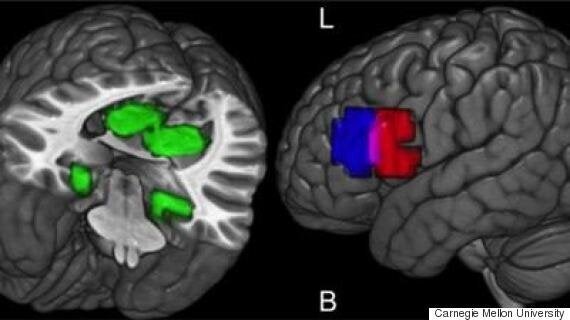Scientists are now able to read people's minds using MRI images of the brain that show specific patterns of neural activity.
In an experiment conducted by Carnegie Mellon University in Pennsylvania U.S., researchers deduced what people were thinking about by observing brain activity following a simple learning task.
Their study, funded by the US Office of Naval research, involved teaching a group of 16 people about the diet and habits of eight different animals and observing how they processed the new information.

Using functional magnetic resonance imaging (fMRI), the scientists found that each person had a specific 'brain activation signature' -- an indication of the neural activity -- for the different animals.
So, each person had specific 'habitat' regions in the brain that stored new information about where the animals lived and dedicated 'diet regions' where the newly learned knowledge about animals' diets was stored.
In this image 'habitat' brain regions are represented in green and 'diet' regions in red and blue.

Since each animal invoked specific types of brain activity, scientists were able to use fMRI images and find out what animal each person was thinking about at any given time.
Describing the significance of the research Carnegie Mellon University stated that the program was in effect 'reading their (participants) minds as they contemplated a brand-new thought.'
The wider implication of this is that scientists could one day use this method to look inside our minds and find out what type of objects we're thinking about but based on this study alone, the method would only apply to objects such as houses, bananas or cars and not abstract thoughts.
The research, published in Human Brain Mapping, also revealed that animals that had shared diets or habitats gave rise to similar brain signatures.
Co-author and neuroscientist Marcel Just said: “The activation signature of a concept is a composite of the different types of knowledge of the concept that a person has stored, and each type of knowledge is stored in its own characteristic set of regions.”
Alongside the potentially scary thought of other people being able to read our minds, the study is also significant for learning about how the human brain processes new information.
Lead author Andrew Bauer explained:
“Each time we learn something, we permanently change our brains in a systematic way.
“It was exciting to see our study successfully implant the information about extinct animals into the expected locations in the brain’s filing system."
READ MORE:
Bauer and Just's paper concluded that our brains all use a similar 'filing system' to process new information.
They claim their results will be able to help develop more effective ways of teaching complicated subjects in school as well as shed light on how to reverse the loss of knowledge that accompanies disorders such as Alzheimer and dementia.